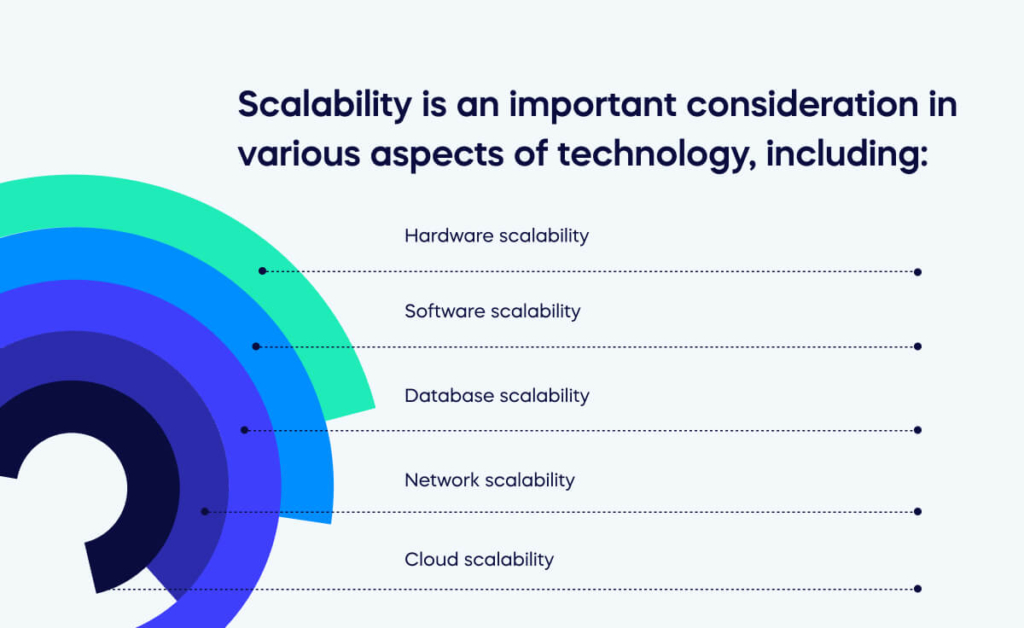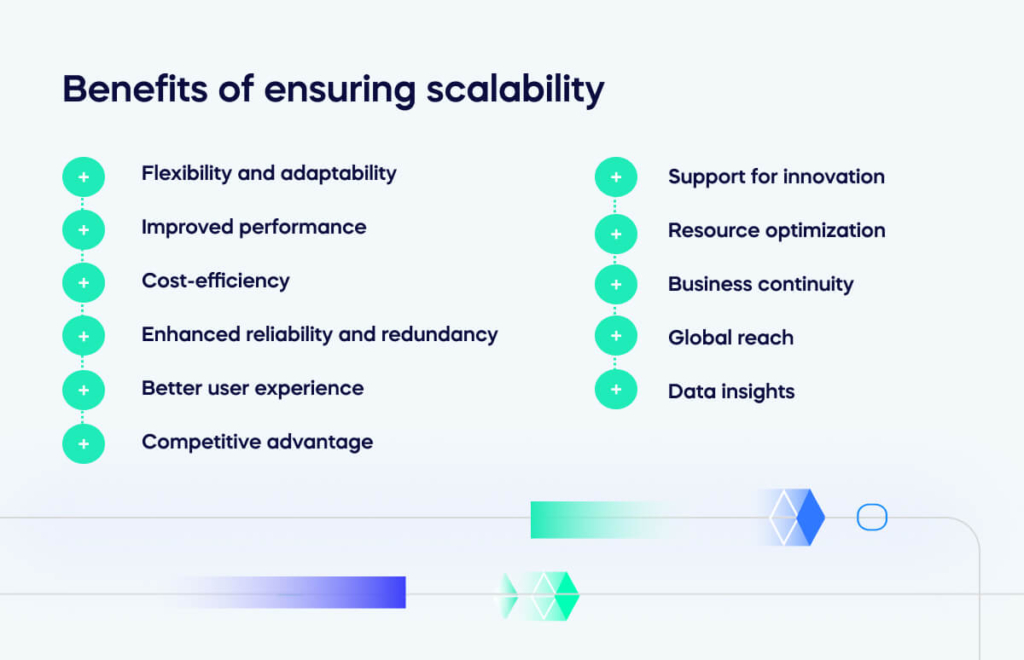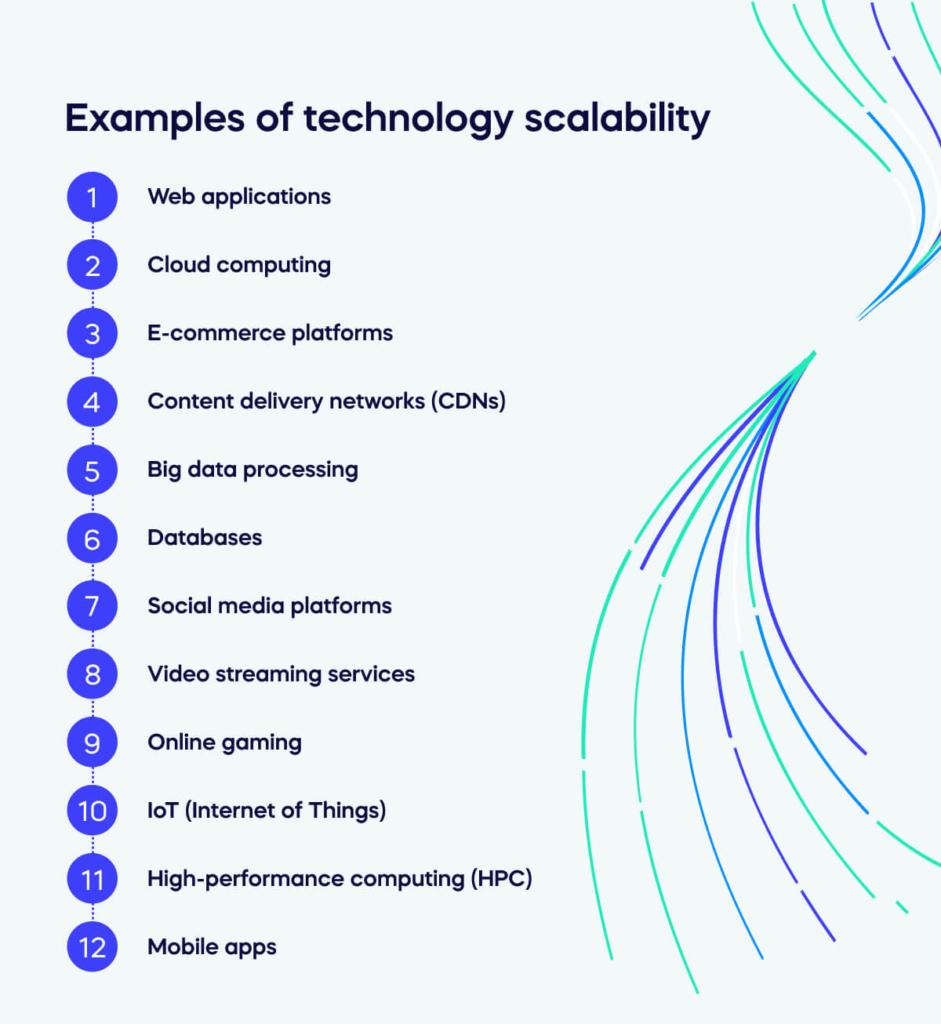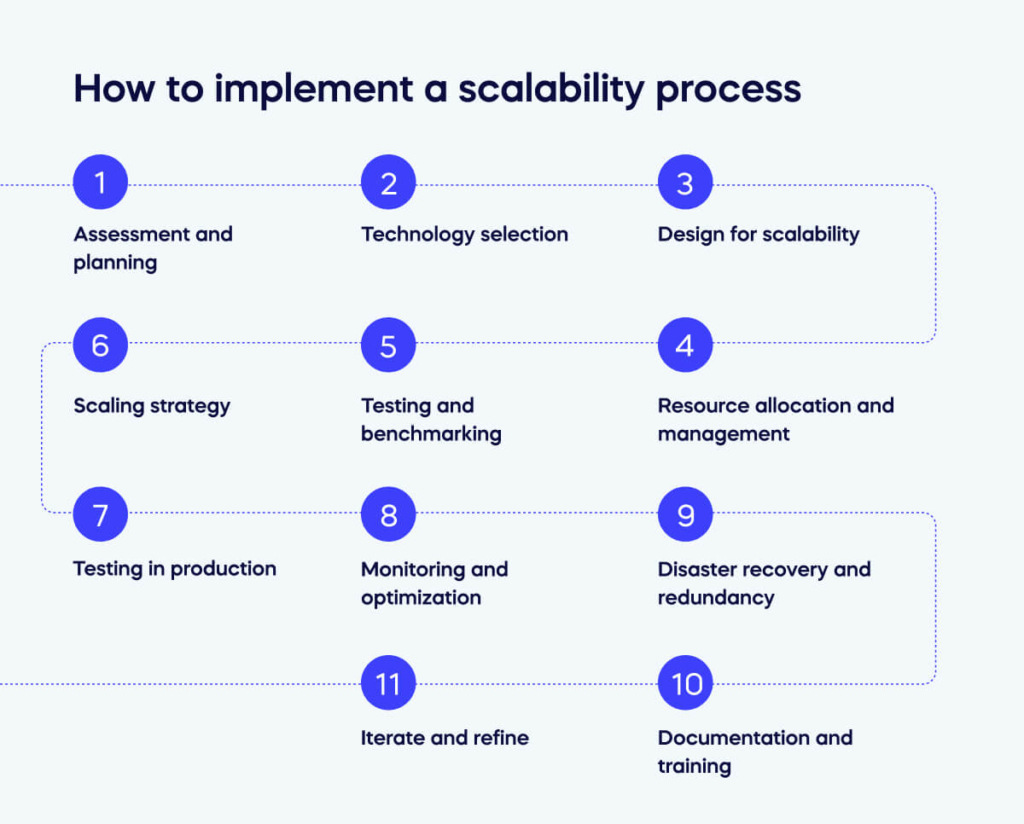Technology scalability refers to the ability of a technology, system, or software to handle an increasing amount of work, users, or data without a significant decrease in performance or a need for major modifications.
In essence, it measures how well a technology can grow and adapt to meet the demands of a larger or more complex environment.
Scalability is an important consideration in various aspects of technology, including:
Hardware scalability
This refers to the ability to expand or upgrade the hardware components of a system, such as adding more processors, memory, storage, or network capacity, to accommodate increased workloads or user demands.
Software scalability
Software scalability involves designing applications or systems to efficiently handle increased usage or data. This can include optimizing code, utilizing distributed architectures, and using efficient algorithms.
Database scalability
Database systems must scale to handle increasing amounts of data and user requests. This can be achieved through techniques like database sharding (partitioning data across multiple servers), replication, and caching.
Network scalability
Network infrastructure must be scalable to accommodate more devices, users, or increased data traffic. Load balancing, redundancy, and network design are considered for such an endeavor.
Cloud scalability
Cloud services and infrastructure are designed to be highly scalable, allowing organizations to increase or decrease their computing resources based on demand. This is often referred to as “elasticity.” Research from OpsRamp reveals that 62% of organizations increasingly use cloud-native infrastructure for operational scalability and flexibility.
Scalability is crucial for businesses and organizations to meet the evolving needs of their customers and users. It ensures that systems can grow cost-effectively and adapt to changing requirements without needing a complete overhaul.
Scalable technologies are often associated with improved performance, reliability, and the ability to deliver a consistent user experience (UX), even as demands increase.
There are different types of scalability, including vertical scalability (adding more resources to a single node) and horizontal scalability (adding more nodes or instances in a distributed system).
The choice of scalability approach depends on the specific technology, its architecture, and the nature of the workload it needs to handle.

Benefits of ensuring scalability
According to a recent IEEE study, big data technologies have seen massive growth and scalability due to advances in infrastructure and virtualization technology.
Ensuring scalability in technology and systems offers several important benefits, which can be particularly valuable for businesses and organizations.
Some of the key advantages include:
Flexibility and adaptability
Systems have the remarkable ability to adjust to evolving demands and accommodate expansion without necessitating a total revamp. This inherent flexibility empowers organizations to effectively address heightened needs, seize emerging prospects, and adapt to shifting market dynamics.
Improved performance
Scalable systems can maintain or even enhance their performance as they grow. Therefore, users or customers can continue to access services or applications quickly and efficiently, even as the workload increases.
Cost-efficiency
Organizations can add resources incrementally rather than making large, costly upfront investments.
Enhanced reliability and redundancy
Redundancy and failover mechanisms are often incorporated, making these systems more reliable. If one component fails, there are backup components to ensure continued operation, reducing downtime and improving system resilience.
Better user experience
A consistent and reliable user experience is provided, even during periods of high demand. Customer retention and good levels of user satisfaction are maintained.
Competitive advantage
Scalability can give organizations a competitive edge by enabling them to handle more users, data, or transactions than their less scalable competitors.
Support for innovation
These systems are more adaptable to incorporating new technologies, features, or services. This facilitates innovation and lets businesses stay updated with the latest trends and customer expectations.
Resource optimization
Efficient resource allocation is enabled, ensuring that computing resources are used effectively.
Business continuity
Business continuity is ensured as unexpected increases in demand are accommodated. Furthermore, the systems provide redundancy in case of hardware or software failures.
Global reach
Global audiences are better served, as solutions can be designed to handle increased user loads in various locations.
Data insights
Scalable data systems can handle larger volumes of data, enabling organizations to gain deeper insights from their data and make data-driven decisions.

Consequences of not scaling effectively
Failing to scale technology or systems effectively can have a range of negative consequences for businesses and organizations.
These consequences can hinder growth, decrease efficiency, and negatively impact customer satisfaction.
Some of the notable consequences of not scaling effectively include:
Performance issues
Inadequately scaled systems can experience performance bottlenecks, leading to slow response times, system crashes, or unresponsiveness. This can frustrate users and lead to a poor user experience.
Downtime
Overloaded systems may experience more frequent downtime due to hardware or software failures, leading to service disruptions. Downtime can result in lost revenue, decreased productivity, and damage to an organization’s reputation.
Inefficient resource utilization
Without effective scalability, resources may be overprovisioned, leading to unnecessary expenses. If they are underprovisioned, this can result in resource shortages during peak usage periods.
Inability to meet demand
A lack of scalability can prevent organizations from seizing opportunities or accommodating sudden spikes in demand, such as during seasonal peaks or unexpected surges in interest.
Increased operational costs
Maintaining and upgrading non-scalable systems can be costly and time-consuming. It may involve frequent manual interventions, customizations, and workarounds, leading to higher operational expenses.
Competitive disadvantage
Organizations that cannot scale effectively may lose ground to competitors who can provide better, more scalable services.
Ineffective data management
Inflexible data systems may be unable to handle growing data volumes, hindering data analysis and decision-making.
Regulatory compliance issues
Regulatory requirements might change in some industries, and organizations must adapt their systems to remain compliant. Non-scalable systems may struggle to meet these evolving compliance needs.
Difficulty in expansion
Non-scalable systems can impede an organization’s ability to expand geographically or diversify its product or service offerings, limiting growth potential.
Reputation damage
Continual performance problems and downtime can harm an organization’s reputation, eroding customer, partner, and stakeholder trust.
Security vulnerabilities
Inflexible systems may not be updated or patched promptly, leaving them vulnerable to security breaches and cyberattacks.
Operational inefficiency
Non-scalable systems can lead to inefficiencies in day-to-day operations, affecting productivity and employee morale.
Vertical vs horizontal scalability
Vertical scalability and horizontal scalability are two different approaches to expanding the capacity and performance of a system or technology.
Each approach has its own advantages and use cases, and the choice between them depends on the specific requirements and constraints of the system.
Vertical scalability (scale-up)
Vertical scalability, often called “scaling up,” involves adding more resources to a single server or component of a system to enhance its performance and capacity.
Resources typically include adding more CPU cores, increasing memory, or upgrading to a more powerful processor. It can also involve adding additional storage or improving the network bandwidth of a single server.
Vertical scalability is usually associated with monolithic architectures, where the application or system runs on a single large server.
It is suitable for workloads where a single, powerful machine can meet the requirements and when it’s feasible to add resources to that machine.
It may be less cost-effective compared to horizontal scalability, as upgrading individual components can be expensive and may lead to a limited ceiling in terms of performance and capacity.
Horizontal scalability (scale-out)
Horizontal scalability, often called “scaling out,” involves adding more machines or nodes to a distributed system to improve its performance and capacity.
Resources are added by deploying additional servers or instances, and the workload is distributed across these nodes.
Horizontal scalability is typical in modern, distributed, and cloud-based architectures, such as microservices and containerized applications.
It is suitable for workloads that can be divided into smaller, independent tasks and distributed across multiple nodes.
Horizontal scalability is often more cost-effective, allowing organizations to use commodity hardware and scale by adding relatively inexpensive servers or instances.
Comparison
Vertical scalability offers a simpler approach to scaling because it involves enhancing the capabilities of existing hardware.
However, it may have limitations regarding the maximum achievable capacity and performance, and it can be cost-prohibitive when high-end hardware is required.
Horizontal scalability offers a highly adaptable and cost-effective approach to scaling, especially for workloads that can be distributed across multiple nodes. This approach enhances resilience and fault tolerance by preventing a single node failure from damaging the entire system.
However, it does necessitate more intricate architecture and management to facilitate seamless communication and data sharing among multiple nodes. In practice, many organizations use a combination of vertical and horizontal scalability to address different aspects of their systems.
For example, they may vertically scale a database server to increase processing power and horizontally scale web servers to handle increased user requests.
Examples of technology scalability
Having an example always helps in understanding a concept better.
This section will look at a few examples of technology scalability to demonstrate how it works in real-world scenarios.
Web applications
A web application that can handle a growing number of users without significant performance degradation or downtime is an example of scalability.
This often involves horizontal scalability, where additional web server instances are added to distribute user requests.
Cloud computing
Cloud services like Amazon Web Services (AWS), Microsoft Azure, and Google Cloud provide scalable infrastructure and resources.
Organizations can easily scale their computing, storage, and networking resources up or down based on demand, paying only for what they use.
E-commerce platforms
E-commerce websites need to scale to accommodate increased traffic during holidays or promotions.
Scalability is achieved by adding more servers, employing load balancers, and optimizing databases to ensure a smooth shopping experience.
Content delivery networks (CDNs)
CDNs use distributed server networks to deliver content, such as images, videos, and web pages, to users from the nearest edge server.
This approach enhances the scalability of content delivery and reduces latency.
Big data processing
Scalability is crucial in big data processing platforms like Apache Hadoop and Apache Spark.
These systems can scale horizontally by adding more processing nodes to handle large data volumes and complex analytics tasks.
Databases
Scalable databases can handle large datasets and high query loads. Examples include NoSQL databases like MongoDB, which can scale horizontally by adding more nodes, and traditional relational databases that can use techniques like database sharding.
Social media platforms
Social networks like Facebook and Twitter must be highly scalable to accommodate millions of users and their interactions.
Horizontal scalability and distributed architectures are commonly used to meet these demands.
Video streaming services
Services like Netflix and YouTube need to handle varying levels of streaming traffic. Scalable video streaming platforms use content delivery and adaptive technologies to ensure a smooth viewing experience.
Online gaming
Online gaming platforms require scalability to support a large number of players concurrently.
Scalability is achieved by using game server clusters and distributed server architectures.
IoT (Internet of Things)
Scalability is essential for IoT systems that collect data from a vast number of devices and sensors. Edge computing and scalable data processing are used to manage and analyze IoT and Industry 4.0 data.
High-performance computing (HPC)
In scientific and research computing, high-performance clusters can be scaled to perform complex simulations and data analyses. Adding more nodes to a cluster enhances its computing power.
Mobile apps
Scalable mobile apps can accommodate a growing user base and evolving features. Backend-as-a-Service (BaaS) and cloud-based app services offer scalability options for mobile applications.

How to implement a scalability process
Implementing a technology scalability process involves a series of steps and considerations to ensure that your technology and systems can grow and adapt to changing demands efficiently. Here’s a general guide on how to implement technology scalability:
Assessment and planning
Define objectives
Start by clearly defining your scalability objectives. Determine what aspects of your technology or systems need scalability (e.g., servers, databases, network, software).
Performance metrics
Identify the key performance metrics that will help you measure the effectiveness of your scalability efforts. This may include response time, throughput, resource utilization, and user satisfaction.
Capacity analysis
Analyze your current capacity and usage patterns to understand where scalability is needed. This can involve monitoring resource utilization and identifying potential bottlenecks.
Growth projections
Project your expected growth and demand over a certain timeframe. This will help you anticipate when and where scalability will be required.
Technology selection
Choose scalable technologies
Select technologies, frameworks, and architectures that inherently support scalability. For example, cloud computing platforms, microservices, and NoSQL databases are known for their scalability features.
Scalable hardware
If you’re dealing with physical hardware, choose components that can be upgraded or expanded, such as servers with multiple CPU sockets and RAM slots.
Design for scalability
Architectural design
Implement an architecture that supports scalability, such as distributed systems, load balancing, and horizontal scaling. Ensure modularity and component isolation.
Stateless design
Whenever possible, design your systems to be stateless, meaning they don’t rely on the local state of a server. This makes it easier to scale horizontally.
Database design
Choose databases that can handle large data volumes and be scaled vertically and horizontally. Implement appropriate indexing and partitioning strategies.
Caching and content delivery
Utilize caching mechanisms and content delivery networks (CDNs) to reduce the load on your infrastructure and improve performance.
Resource allocation and management
Resource monitoring
Continuously monitor your system’s resource usage to identify performance bottlenecks and areas where additional resources are needed.
Auto-scaling
Implement auto-scaling mechanisms that automatically add or remove resources based on predefined thresholds. This is particularly important in cloud environments.
Load balancing
Use load balancers to evenly distribute incoming traffic across multiple server instances, ensuring efficient resource utilization and fault tolerance.
Testing and benchmarking
Stress testing
Conduct stress tests to assess how your system behaves under high loads. Identify performance bottlenecks and adjust your scalability plan accordingly.
Benchmarking
Establish baseline performance benchmarks to compare against when making scalability improvements. Regularly re-evaluate and adjust these benchmarks.
Scaling strategy
Vertical scaling
When necessary, consider upgrading individual components (e.g., adding more RAM and CPU cores) to vertically scale. This is often a quick fix but may have limitations.
Horizontal scaling
Emphasize horizontal scaling by adding more instances or nodes to your system. Implement distributed technologies like container orchestration platforms (e.g., Kubernetes) or serverless computing.
Testing in production
Implement a phased approach to scaling in production. Start with a small-scale deployment and gradually increase resources as needed.
Monitoring and optimization
Continuously monitor your system’s performance and resource utilization, making real-time adjustments as required.
Optimize code, queries, and configurations to reduce resource consumption and improve efficiency.
Disaster recovery and redundancy
Implement redundancy and disaster recovery mechanisms to ensure system availability even during failures or outages.
Documentation and training
Document your scalability strategies, configurations, and best practices. Train your team on how to manage and maintain scalable systems effectively.
Iterate and refine
Scalability is an ongoing process. Regularly review your scalability plan and adjust for future growth and changes.
